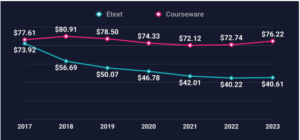College and university learning management systems (LMS) are making strides in the market for student materials, building on exponential increases since the pandemic, according to a new report from Vital Source.
The Annual Course Materials Report studied student retail habits by analyzing purchases made from online retailers during Winter 2022 and Spring 2023 and found that about a fifth (19%) of all students now purchase course materials directly through their LMS rather than through standard retail options. This proportion of students is more than twice as high as last year (7%) and five times greater than the year before (3%).
About half (49%) of all LMS purchases were for digital materials rather than physical print options. With students increasingly preferring to purchase class materials via their LMS and the proportion of those being digital, the report suggests print textbooks and related materials are reaching their twilight.
This is the first year the sale of digital units eclipsed used physical textbooks, while digital surpassed physical rentals in 2020. Similarly, electronic textbooks have nearly split the student market with regular courseware and bundles, with the former now making up 45%, a 5% boost from last year.
Blackboard, Canvas, Moodle and D2L are among the most well-recognized LMS.
More from UB: Online learning is on the verge of besting the traditional classroom, report finds
What’s driving student preference toward LMS?
After being pushed online due to the pandemic, students have begun to discover the incentives of purchasing materials directly through LMS.
First, students can conveniently purchase their materials within the school system rather than shopping elsewhere. And because the materials are directly available from the LMS, it negates the room for erroneous purchases. Moreover, materials are available on day one of class.
Lastly, and arguably the most influential, is that LMS materials are continuously becoming more affordable by a widening margin. Appalachian State University’s decision to move digital-first in its textbook rental program in Fall 2021 saved students over $5 million in the past academic year, according to Appalachian Today. While the average per semester cost of course materials across the North Carolina System was over $1,100 per year, Appalachian State’s hovered in at $260.

Edtech market booms
With the rate of student preference toward LMS exponentially rising, the market value is going up with. The Insight Partners speculate the LMS market to elevate at a compound annual growth rate (CAGR) of over 19% by 2028, reaching $50.99 billion.
With or without an LMS, electronic textbooks, or etexts for short, are due for a similar turn. Thanks to etexts, similar features of LMS, such as great pricing models and trends toward e-commerce, the market is set to register a CAGR of 21% between 2022 and 2027, according to Technavio.







